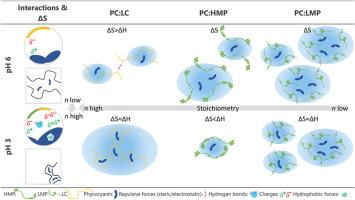研究节肢动物板蓝根提取物与高甲氧基化果胶、低甲氧基化果胶和λ-卡拉胶的相互作用力和络合物的形成
IF 11
1区 农林科学
Q1 CHEMISTRY, APPLIED
引用次数: 0
摘要
为了稳定来自节肢动物板蓝根的蓝色色素藻蓝蛋白,人们探索了许多复合机制。然而,以往的研究主要侧重于各种方法的应用,而不是深入研究分子间的相互作用。本研究比较了酯化程度高和酯化程度低的柑橘果胶以及λ-卡拉胶的相互作用。目的是找出一种适合络合的分子,这种分子在加热后仍能保持颜色和胶体稳定性。利用动态光散射和静态光散射对各种复合物的尺寸进行了测量,并对 ZETA 电位等特性进行了表征。此外,还通过等温滴定量热法和计算盲对接研究了复合物的作用机理。在非极性基团之间的疏水相互作用和范德华力的作用下,熵增促进了弱络合物的形成。这一步似乎是形成核壳结构的关键。pH 值的降低导致静电相互作用增强,从而强化了复合物的形成,使焓值从 -4 至 -23 kJ٠mol-1 之间转变为 -15 至 -25 kJ٠mol-1。在蛋白质表面发现了多个结合位点,主要涉及极性基团。与精氨酸的相互作用尤为显著,尽管苏氨酸在蛋白质序列中更为突出,但与精氨酸的相互作用次数却达到了 28 次,而与苏氨酸的相互作用次数仅为 8 次。这些相互作用被认为与异叶花青素和 c-植物花青素亚基之间的相互作用以及蛋白质发色团之间的相互作用相竞争,从而导致颜色偏移。这项研究强调了选择合适的生物聚合物以获得最佳性能的重要性,同时考虑到了强相互作用与体积之间的微妙平衡,以防止出现复杂的沉淀。本文章由计算机程序翻译,如有差异,请以英文原文为准。

Study of interactive forces and complex formation from Arthrospira platensis extract with high methoxylated pectin, low methoxylated pectin and lambda-carrageenan
Numerous complexation mechanisms have been explored to stabilize the blue pigment phycocyanin from Arthrospira platensis. However, previous studies have primarily focused on the application of various methods rather than delving into molecular interactions. This study compared the interactions of citrus pectins with a high degree of esterification and a low degree of esterification as well as lambda-carrageenan. The goal was to identify a molecule suitable for complexation that maintains stability against heating in terms of color and colloidal stability. Size measurements employing dynamic light scattering and static light scattering, as well as characterization of properties such as zeta potential, were performed for the various complexes. Moreover, the complexation mechanism was investigated by isothermal titration calorimetry and computational blind docking. Weak complexes were formed at neutral pH, driven by an entropy gain facilitated by hydrophobic interactions and van der Waals forces between non-polar groups. It seems that this step is essential in achieving structures with a core shell formation. A decrease in pH resulted in intensified complex formation driven by enhanced electrostatic interactions, leading to a shift in enthalpy from values between −4 and −23 kJ٠mol−1 to values between −15 and −25 kJ٠mol−1. Multiple binding sites were identified across the protein surfaces, primarily involving polar groups. Interactions with arginine were particularly significant, exhibiting 28 interaction counts compared to only 8 for threonine, despite threonine's greater prominence in the protein sequence. These interactions are thought to compete with interactions between allophycocyanin and c-phycocyanin subunits and protein chromophore interactions, resulting in a color shift. The study highlights the importance of selecting the appropriate biopolymer for optimal performance, considering the delicate balance between strong interactions and bulkiness to prevent complex precipitation.
求助全文
通过发布文献求助,成功后即可免费获取论文全文。
去求助
来源期刊

Food Hydrocolloids
工程技术-食品科技
CiteScore
19.90
自引率
14.00%
发文量
871
审稿时长
37 days
期刊介绍:
Food Hydrocolloids publishes original and innovative research focused on the characterization, functional properties, and applications of hydrocolloid materials used in food products. These hydrocolloids, defined as polysaccharides and proteins of commercial importance, are added to control aspects such as texture, stability, rheology, and sensory properties. The research's primary emphasis should be on the hydrocolloids themselves, with thorough descriptions of their source, nature, and physicochemical characteristics. Manuscripts are expected to clearly outline specific aims and objectives, include a fundamental discussion of research findings at the molecular level, and address the significance of the results. Studies on hydrocolloids in complex formulations should concentrate on their overall properties and mechanisms of action, while simple formulation development studies may not be considered for publication.
The main areas of interest are:
-Chemical and physicochemical characterisation
Thermal properties including glass transitions and conformational changes-
Rheological properties including viscosity, viscoelastic properties and gelation behaviour-
The influence on organoleptic properties-
Interfacial properties including stabilisation of dispersions, emulsions and foams-
Film forming properties with application to edible films and active packaging-
Encapsulation and controlled release of active compounds-
The influence on health including their role as dietary fibre-
Manipulation of hydrocolloid structure and functionality through chemical, biochemical and physical processes-
New hydrocolloids and hydrocolloid sources of commercial potential.
The Journal also publishes Review articles that provide an overview of the latest developments in topics of specific interest to researchers in this field of activity.
 求助内容:
求助内容: 应助结果提醒方式:
应助结果提醒方式:


